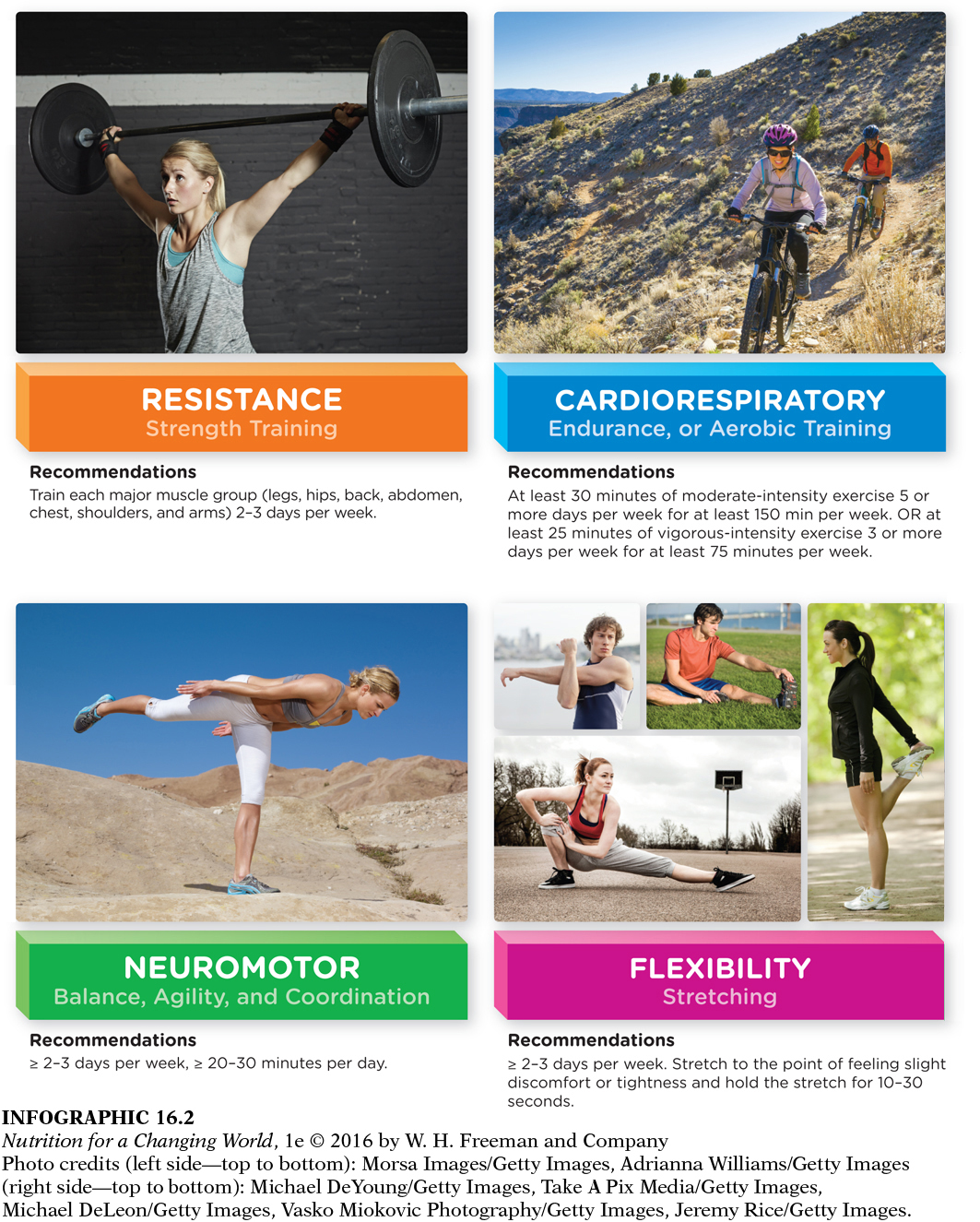COMPONENTS OF FITNESS
PHYSICAL ACTIVITY any bodily movement produced by skeletal muscles that causes energy expenditure
EXERCISE intentional physical exertion
Physical activity is any bodily movement produced by skeletal muscles—whether it’s running, playing a sport, brushing our teeth, vacuuming, or walking to school. Physical activity can be spontaneous and integrated into our activities of daily living (nonexercise activity thermogenesis, as discussed in Chapter 15), or it can be a planned, discrete, and intentional bout of activity called exercise. Generally, more physical activity, either through activities of daily living or planned exercise results in a higher level of physical fitness, as well as better physical and mental health. If exercise were a life-saving drug, some say, it would be the most beneficial, effective, and affordable drug in the world. In the short term, exercise helps people lose body fat, build muscle mass, and become physically fit, while over the long term, research suggests that regular exercise reduces the risk of heart disease, stroke, type 2 diabetes, osteoporosis, and certain cancers; ultimately, it lowers a person’s risk of premature death. Regular exercise has also been demonstrated to help manage stress while reducing anxiety and symptoms of depression. Recent studies have demonstrated that moderate-intensity activity, like jogging for as little as 10 minutes per day (most days of the week), can significantly reduce the risk of CVD and all-cause mortality, with additional exercise bringing greater benefits. While the optimal exercise dose has yet to be defined, new evidence also suggests that the benefits of exercise may diminish when duration or intensity are excessive. (INFOGRAPHIC 16.1)
INFOGRAPHIC 16.1 Benefits of Regular Exercise Exercise decreases the overall risk of death. The majority of benefits are associated with cardiorespiratory fitness, the ability of the circulatory and respiratory systems to supply oxygen to muscles during sustained physical activity.

My Good Images/Shutterstock
RESISTANCE ACTIVITIES activities performed against an opposing force that increase muscle strength, improve body composition, and promote healthy bone density
CARDIO-RESPIRATORY ACTIVITIES activities that increase the heart rate and promote increased use of oxygen to improve overall body condition and endurance
NEUROMOTOR ACTIVITIES activities that incorporate motor skills such as balance, coordination, and agility (also known as functional fitness)
FLEXIBILITY ACTIVITIES activities that promote the ability to move joints through their whole span of movement
Even though Hubbell’s passion is ice dancing, her training regimen encompasses many types of physical exercise, including the four types of exercise recommended by the American College of Sports Medicine for promoting maximal health and preventing diseases and injuries: resistance, cardiorespiratory, neuromotor, and flexibility. (INFOGRAPHIC 16.2) All of these types of exercise are recommended for adults.
Page 367
INFOGRAPHIC 16.2 Types of Exercise and Physical Activity Recommendations for Adults A fitness program should regularly include all four types of exercise. For those with low baseline physical fitness, aerobic exercise for a shorter time, or at a lower intensity than recommended, can still result in improved fitness.

Morsa Images/Getty Images
Michael DeYoung/Getty Images
Adrianna Williams/Getty Images
Take A Pix Media/Getty Images, Michael DeLeon/Getty Images, Vasko Miokovic Photography/Getty Images, Jeremy Rice/Getty Images.
To succeed as a competitive ice dancer, however, Hubbell has to do more than just train vigorously. She also has to eat carefully to achieve and maintain a body composition that is optimal for her sport. Hubbell already had a very healthy diet—often, the qualities that make a person athletic, such as self-awareness and self-discipline, also induce them to make healthy food choices—but according to her coaches, she still needed to make changes. They believed Hubbell could find some competitive advantage by slightly reducing her percentage of body fat, but she needed to do this without compromising her strength or health.
Page 368
To get sound nutrition guidance, she asked around for nutritionist recommendations. Several colleagues pointed her to Dan Benardot, PhD, a sports nutritionist and registered dietitian who runs the Laboratory for Elite Athlete Performance at Georgia State University in Atlanta. Benardot has spent his career studying what foods athletes should eat and when they should eat them. So, Hubbell paid Benardot a visit in Atlanta. Benardot was indeed the right person to go to: He had been in charge of nutritional strategy for the U.S. Women’s Gymnastics Team from 1992 to 1996.
Page 369
For Hubbell to meet her goals, Benardot recommended that she should eat small meals frequently throughout the day—not more than 600 calories in one sitting. He also told Hubbell to ignore the advice she had heard about avoiding carbohydrates. “He said, ‘That’s completely backwards— you have to eat a lot of carbs,’” Hubbell recalls.
CATABOLISM the breakdown of body muscle and tissue
ANABOLISM the process of building up body muscle and tissue
Eating at regular intervals throughout the day will allow athletes to avoid extended periods of calorie deficit that can lead to catabolism, which is the breakdown of large molecules (protein, fat, and glycogen) into smaller ones, causing a loss of skeletal muscle mass. When sufficient glucose is not available, the body will accelerate the breakdown of muscle proteins to provide the amino acids that are required to synthesize the needed glucose, which leads to a reduction in lean body mass—something most athletes want to avoid. This is exactly the opposite of anabolism, the process by which the body synthesizes protein, fat, and glycogen; and builds muscle mass and lean tissue. To build muscle and increase the proportion of lean tissue to fat tissue, both athletes and nonathletes must consume adequate calories to prevent catabolic processes from exceeding anabolic processes over the course of the day, while engaging in activities (primarily resistance training) that promote muscle growth.

